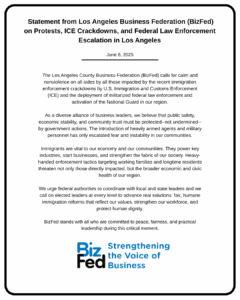By David M Smith
Posted on 5/20/2016
LA Daily News
On Friday, the California Economic Development Department released its monthly employment figures and many passive observers were probably cheered by the news. California added 59,600 jobs in April and unemployment in the state dipped to 5.3 percent, down from 5.4 percent a month earlier.
The problem with employment numbers is that they can tell a conflicting and incomplete story. While there is job growth in Los Angeles — employment increased by 22,000 and the seasonally adjusted unemployment rate in Los Angeles County declined over the month to 5.1 percent — there is still a large number of unemployed. In fact, Los Angeles County has 259,000 unemployed persons. Those numbers fail to capture the many people who have run through their unemployment benefits and are no longer reported in unemployment data.
A more telling measure comes from the U.S. Bureau of Labor Statistics. Named U-6, this unemployment figure reflects the total unemployed sector — including all marginally attached workers and those employed part time for economic reasons — as a percent of the civilian labor force. In California, the most recent U-6 unemployment rate (released April 22) is 12.0 percent — tying California with Arizona as the third-highest in the United States. In Los Angeles, the U-6 rate is a troubling 12.8 percent.
A newly released survey by the Los Angeles County Business Federation (BizFed) underscores the problem. According to BizFed, about 64 percent of small business respondents expect business conditions will be either significantly or slightly better than they were in 2015. But only 41 percent report plans to hire this year, and an additional 41 percent of respondents anticipate “no significant change” in employment outlook for 2016. The data is almost exactly the same as poll results from 2015. For Californians who have had no success in finding a job and have simply given up, the prospects are bleak.
In order to bring more discouraged workers back into the employment picture, the hiring environment has to improve for local employers.
Los Angeles County is home to more than 244,000 businesses, most of which are small enterprises. If our region is to continue to grow and thrive, policy makers can focus on three areas to help mitigate economic uncertainty and stimulate hiring those currently on the sideline.
First, small businesses must have expanded access to capital. While it goes without saying that businesses need funding to invest in their operations and expand their workforce, research we’ve conducted at Pepperdine University with Dun & Bradstreet indicates that small businesses are getting loans less than half the time they apply. As a result, 61 percent say their growth opportunities are restricted, and 53 percent feel their ability to hire is restricted. We also found that business owners are increasingly seeking capital from alternative sources such as business credit cards, personal credit cards and personal loans. Because our nation’s banks have yet to increase lending to pre-recession levels, we have to make it easier for small businesses to access capital. In federal budget considerations, Congress must prioritize programs such as the SBA 7(a) loan and Certified Development Company programs, which will help small businesses operate and expand.
Second, Los Angeles must adopt business-friendly public policies. Policy makers in Sacramento must reform existing regulatory barriers to small business success and growth, such as the California Environmental Quality Act (CEQA), which everyone knows is a tool used by special interest groups to stall development. Reforming CEQA, which is alluded to in Gov. Jerry Brown’s May budget revision, also has a direct impact on creating affordable housing in Los Angeles. In addition, Los Angeles-area businesses report that the cumulative fiscal impact of taxes and fees is overwhelming; indeed, the BizFed survey found that business owners have reported taxes and fees as their top business concern for six years straight.
Finally, our state educational system must align the workforce with projected jobs of the future. Following the loss of employment in key industries such as oil and aerospace, our region has struggled to maintain a strong middle class rooted in stable, good-paying jobs. A projected six out of 10 jobs in the next 10 years will require education beyond high school, so workforce training is a necessity for long-term job growth. A place to start would be to invest even more in the successful worker training and retraining program, California Employment Training Panel, by doubling the number of workers and veterans trained to 15,000 Californians.
In the Cal EDD data released on Friday discouraged workers were barely a side note. If Los Angeles hopes for a full recovery from the recession and discouraged workers are to re-enter the workforce, policy makers must do all they can to promote innovation, support entrepreneurism and jump-start business hiring.
David M. Smith, Ph.D., is dean and a labor economist at Pepperdine University’s Graziadio School of Business and Management.
//

